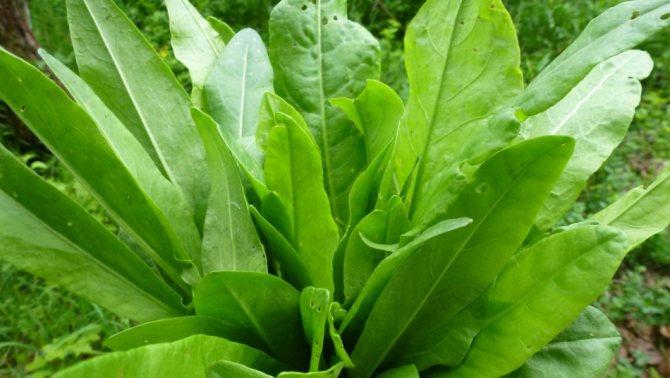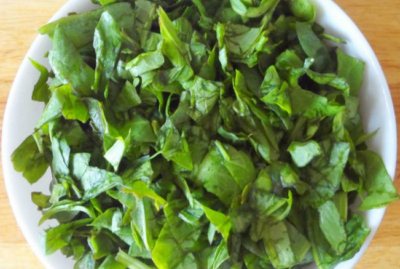Substances in the composition due to which there are restrictions
The composition of sorrel, in addition to a huge number of useful elements, includes biochemical compounds - oxalic and citric acids. It is because of this fact that the plant can hardly be included in the list of suitable products for baby food.
Only the developing digestive system of the child is too “tender” for “aggressive” compounds, which is fraught with the further development of gastritis, ulcers, and pancreatitis in the baby. In addition, a huge amount of minerals and salts can change the composition of urine and easily precipitate. As a result, there is an increased risk of developing urolithiasis, kidney inflammation or other diseases of the excretory system.
Benefit
Despite the many beneficial properties of sorrel, it should be introduced into a child’s diet no earlier than 3 years.
The vitamin and mineral complex of sorrel has a beneficial effect on the body:
- A large amount of molybdenum promotes better absorption of iron, ascorbic acid and other beneficial substances.
- Sorrel exhibits antibacterial activity, has an analgesic effect and accelerates the healing of shallow wounds and burns.
- The juice of the plant has an anti-inflammatory effect. Decoctions and infusions of sorrel are used to gargle and gargle for sore throat, sore throat, gingivitis (inflammation of the gums), pharyngitis (inflammation of the pharynx), and toothache.
- The composition of sorrel includes tannic, malic, citric, and pyrogallic acids. Their greatest quantity is contained in young leaves in spring. Thanks to the action of these acids, it is easier to cope with diarrhea, digestion and bile flow improves. Eating sorrel increases appetite.
- The antioxidant properties of vitamins E and A help rid the body of toxic substances. It is no coincidence that in ancient times sorrel was used to make antidotes for snake bites and poisonous insects. These vitamins increase the body's immune defense and speed up the child's recovery from viral infections. Decoctions of the plant help to cope with an unproductive annoying cough and restore a hoarse voice.
- Vitamin B9 and iron in the plant ensure an increase in hemoglobin and the synthesis of red blood cells, which is necessary for prevention and treatment.
- B vitamins and phosphorus support normal brain activity and balance the processes of excitation and inhibition. Children who receive meals with sorrel twice a week are better able to cope with psycho-emotional stress and stressful situations, and their sleep improves.
- Sorrel decoctions help relieve itching and irritation of the skin; they are used for acne in adolescents.
- Ascorbic acid, vitamins K and PP in sorrel thicken the vascular wall and help cope with bleeding gums and nosebleeds.
At what age can it be given, is it possible at 1 year?
Important!
According to the majority of Russian pediatricians, including Dr. Komarovsky, sorrel dishes should be introduced into a child’s menu no earlier than three years of age, and then in small portions and only in the absence of contraindications.
To prepare dishes with sorrel intended for a baby, it is necessary to select only young leaves formed before the plant blooms and the shoots are pasted. In young greens, the concentration of oxalic acid has not yet reached high levels, which makes it safer for children’s stomachs.
The permissible frequency of a child’s consumption of dishes with sorrel is 1-2 times a week.
Is it possible to eat sorrel while breastfeeding?

There is no clear answer to this question. Some doctors believe that sorrel is extremely beneficial, while others are confident that it can only harm a nursing mother and her baby.
For those women who cannot imagine their lives without this useful herb, we can only give a number of tips that they will have to follow when consuming sorrel while breastfeeding:
- Before eating sorrel, it must be thoroughly washed.
- It’s better to choose a proven product from a trusted seller or use grass you grow yourself.
- It is advisable to consume sorrel no more than 2 times a week.
- At the first sign of allergic reactions in mother or baby, you should immediately discard this herb.
Signs of an allergy to sorrel in an infant may include:
- Presence of dryness, itching and rashes
- Nasal congestion and sneezing
- Redness of the eye
- Swelling, redness and tearing of the eyes.
Benefits and harms
The rich vitamin and mineral complex provides the herbaceous plant with a number of positive properties. Regular consumption of sorrel can:
- prevent the development of anemia;
- strengthen the immune system;
- improve appetite;
- stimulate digestive processes;
- relieve constipation;
- establish metabolic processes;
- saturate the growing body with antioxidants;
- reduce the activity of pathogenic microflora.
It would be appropriate to talk about the benefits of sorrel for the baby’s body only if it is consumed in doses and in a timely manner.
Violation of the age limit, exceeding the recommended frequency of consumption of sorrel can cause:
- metabolic disorder;
- accumulation and deposition of salts in the kidneys and ureters;
- development of urolithiasis;
- food allergies;
- problems with the intake and absorption of calcium, which threatens osteoporosis.
Is it possible for a one-year-old child to have sorrel and sorrel soup?

Is it allowed to feed a one-year-old baby sorrel or green borscht with sorrel?
- If parents are ready to take responsibility for the health of their baby and are confident in his ability to digest this product without harming himself, then no one, of course, has the right to prohibit them from doing so.
- In this case, you must add any fermented milk product (yogurt, sour cream) to the soup or other dish with sorrel.
- But it is still better to refrain from feeding crumbs of dishes with sorrel up to 3 years.
We hope that the information provided in the article will be useful to our readers and will dispel all their doubts regarding such a useful but controversial product as sorrel.
Contraindications for use

Sorrel should not be introduced into the diet of a child if he is diagnosed with:
- individual intolerance;
- problems with the kidneys and their functioning;
- gastritis with high acidity;
- stomach or duodenal ulcer;
- cholelithiasis or urolithiasis;
- disturbances of water-salt metabolism.
Are there any contraindications or restrictions?
There are contraindications to the use of sorrel, and there are many of them.:
- Introducing the product into a child’s diet too early or excessive consumption leads to disruption of mineral metabolism.
Salts of oxalic acid precipitate in the urine, which can lead to the development of urolithiasis or other diseases. - For the health and growth of children, the intake and absorption of sufficient amounts of calcium in the body is very important, and oxalic acid can become a serious obstacle to this path, removing calcium from the body.
- It is strictly forbidden to use sorrel if the child already has gallstones and urolithiasis, gastritis, peptic ulcers, or disorders of water-salt metabolism.
- Eating greens too often will inevitably lead to osteoporosis.
Sorrel is a known allergen . If a child is allergic, the use of sour grass can only be started after consulting a doctor. The child may also suffer from hay fever, a seasonal exacerbation of allergies associated with the flowering of meadow plants.
How to choose a product?
Attention!
It is preferable to buy sorrel in bunches: unscrupulous sellers often hide dried or rotten leaves behind fresh herbs, packing such a mix in plastic containers sealed with cling film.
The products from which food is prepared for children must be of the highest quality. When purchasing, parents should pay attention to several parameters:
- Appearance. The leaves should be fresh, elastic, deep green in color and small in size.
- Aroma. When a sorrel leaf is torn, the plant emits a sour and rich aroma; impurities of other odors (mold or dampness) are not acceptable.
- Presence of signs of insects. Dots of any color, growths, larvae on green leaves are a signal that the plant is affected by aphids or even mites. Under no circumstances should you buy such a product.
Is sorrel good for pregnancy?

Before answering this question, it is necessary to find out why it is so useful for all other people. So, sorrel contains a number of nutrients and microelements necessary for the human body, such as:
- Vitamins A, B, C, E, H, K, PP
- Iodine, fluorine, magnesium, sulfur, phosphorus, calcium, sodium, iron, manganese, copper, zinc, molybdenum
- Oxalic, citric and malic acids
- Tannins
- Essential oils
- Bioflavonoids
- Squirrels
- Carbohydrates
- Fiber
The presence of all these substances allows sorrel to heal the body of pregnant women from diseases such as:
- Gastrointestinal diseases
- Angina
- Bladder diseases
- Liver diseases
- Bleeding of various types
- Stomatitis
- Scurvy
- Dermatological diseases
- Diseases of the joints and musculoskeletal system
- Anemia
In addition, the substances contained in sorrel are excellent immunomodulatory and antioxidant agents.

Why is sorrel dangerous for pregnant women?
However, this herb also has some disadvantages. The acids contained in it interfere with the absorption of calcium, and when they react with it, they form insoluble salts (oxalates). This kind of action can lead to disruption of the musculoskeletal system and destruction of bone tissue. Also, oxalates provoke the appearance of stones in the urinary system.
Oxalic and other acids, entering the stomach, can increase the level of acidity in it. This phenomenon is extremely contraindicated for those who already have an increased level of acid in the stomach.
Such consequences indicate that sorrel should not be consumed only by pregnant women who suffer from the following diseases:
- Gout
- Gastritis
- Stomach or duodenal ulcer
- Diseases of the urinary system
- Arthritis
- Arthrosis
- Individual intolerance to oxalic acid
Feeding rules

Sorrel should be introduced into the diet of a three-year-old child only after heat treatment, and only at the age of eight can a child be offered a salad of fresh leaves.
You can reduce the concentration of oxalic acid in the leaves in the following way: after washing, the plant must be doused with boiling water or boiled for 5 minutes.
Sorrel is an excellent base for cooking:
- salads;
- cold snacks;
- side dishes;
- soups;
- casseroles.
Advice
At first, no more than 2-3 leaves (3-4 years) should be included in the recipe for the prepared dish; subsequently, the amount of greens can be increased to 4-5 leaves (5 years).
It is better if the sour product is combined with dairy products, meat or vegetable broths.
Ideal for sorrel:
- carrot;
- potato;
- zucchini;
- cabbage;
- spinach.
Video on the topic
Recipe for sorrel soup, which can be given to children from 12 months:
Thus, taking into account consumption standards, sorrel dishes are recommended to be introduced into the diet from the age of three in the form of first courses and casseroles. You can prepare vitamin-rich salads from fresh leaves, but sorrel without heat treatment can be given to children from the age of eight. It is recommended to choose young leaves, without signs of rot. It is important to know the conditions under which sorrel is contraindicated for use.
In what form should it be given?
In fresh form, adding chopped leaves to salads, cold appetizers, side dishes, sorrel leaves can be given to a child in very limited quantities only after he reaches 8 years of age. Until this time, the green leaves must be cooked. In addition to boiling and scalding, it is recommended to combine the vegetable with fermented milk products - lactic acid helps to partially “neutralize” oxalic acid. In this case, the beneficial properties of sorrel are lost to a lesser extent than when boiling it.
An excellent option is sorrel with sour cream, but this dish is not suitable for children aged 3+. The best way to give sorrel to a child is sorrel soup. Let's learn how to cook it correctly.











